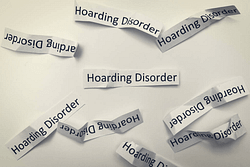Living with hoarding tendencies can be overwhelming and challenging.
Hoarding disorder is a complex mental health condition that affects many individuals, making it difficult to let go of possessions and maintain a clean living environment.
In this blog post, we will explore essential cleaning tips for hoarders, offering guidance on how to declutter, organize, and transform your living space.
By implementing these strategies, you can take significant steps towards reclaiming your space and improving your overall well-being.
Understanding Hoarding Disorder
Before diving into cleaning tips, it's crucial to have a basic understanding of hoarding disorder.
Hoarding is not merely a habit of collecting or messy behavior; it is a mental health condition that requires compassion and patience.
Here are some key points to consider:

1. Hoarding Disorder Defined
Hoarding disorder is characterized by the persistent difficulty in discarding possessions, regardless of their actual value.
Individuals with hoarding disorder experience extreme distress at the thought of parting with items, leading to excessive clutter in their living spaces.

2. Causes and Symptoms
Hoarding disorder can stem from various factors, including genetics, traumatic experiences, and underlying mental health conditions such as obsessive-compulsive disorder (OCD).
Some common symptoms of hoarding disorder include:
- Inability to discard items
- Difficulty organizing possessions
- Severe emotional attachment to objects
- Distress or anxiety when faced with discarding items
- Accumulation of clutter that inhibits normal use of living spaces

3. Seeking Professional Help
If you or someone you know struggles with hoarding disorder, it is essential to seek professional help.
Mental health professionals, such as therapists and psychologists, can provide guidance and develop personalized treatment plans to address the underlying causes of hoarding behaviors.

cleaning tips for hoarders
1. Preparing for the Cleaning Process
Cleaning a hoarded space requires proper planning and preparation.
Here are some important steps to take before diving into the cleaning process:
1. Set Realistic Goals
When tackling a hoarded space, it's crucial to set realistic goals.
Trying to clean up an entire area in one day may lead to frustration and burnout. Instead, break the cleaning process into manageable tasks and set achievable goals for each session.
2. Create a Support System
Cleaning up a hoarded space can be emotionally and physically draining.
It's essential to reach out to friends, family members, or support groups who understand your situation and can provide encouragement throughout the cleaning process.
3. Gather Essential Cleaning Supplies
Before you start cleaning, gather all the necessary supplies.
Some items you may need include cleaning agents, garbage bags, gloves, dust masks, storage bins, and labels.
Having everything on hand will help streamline the cleaning process.

2. The Sorting Process
Sorting through clutter is a vital step in reclaiming your space.
Here's how you can approach the sorting process:
1. Categorize Items
Begin by categorizing items into different groups.
You can create categories such as "keep," "donate," "sell," and "discard." This step helps you make clear decisions about what items are truly essential to keep.
2. Start Small
Start sorting through smaller areas or sections of your living space.
Focusing on one area at a time will prevent overwhelming feelings and allow you to make progress gradually.
3. Use the Four-Box Method
The four-box method is a helpful technique during the sorting process.
Label four boxes or bins as "keep," "donate," "sell," and "discard." Place each item in its respective box based on its value and usefulness in your life.
4. Decision-Making Strategies
If you struggle with decision-making when it comes to discarding items, try asking yourself questions such as:
- Have I used this item in the past year?
- Does this item hold significant sentimental value?
- Can I replace this item easily if needed?
- Will keeping this item contribute positively to my life?

3. Deep Cleaning and Organization
Once you have sorted through the clutter, it's time to deep clean and organize your space.
Follow these tips to make your living environment more functional and comfortable:
1. Clean in Sections
Divide your space into sections and tackle one area at a time.
This approach will prevent feeling overwhelmed and enable you to give each section the attention it needs.
2. Deep Cleaning Techniques
Hoarded spaces often require thorough cleaning to remove dirt, allergens, and odors.
Consider using deep cleaning techniques such as steam cleaning carpets, washing curtains and bedding, dusting surfaces, and scrubbing floors.
3. Functional Storage Solutions
Invest in functional storage solutions to help keep your space organized moving forward.
Shelving units, baskets, clear plastic bins, and label makers can be invaluable tools for maintaining order and making items easily accessible.
4. Establish Daily or Weekly Cleaning Routines
To prevent future clutter buildup, establish daily or weekly cleaning routines.
Committing a specific amount of time each day or week to tidying up will help maintain your newly organized space.

4. Sustaining Progress and Seeking Support
Maintaining a clutter-free environment can be challenging for individuals with hoarding disorder.
Here are some strategies for sustaining progress and seeking ongoing support:
1. Practice Self-Compassion
Remember that change takes time, and setbacks may occur along the way.
Be kind to yourself during this journey and acknowledge your achievements, no matter how small they may seem.
2. Join Support Groups or Therapy
Consider joining support groups specific to hoarding disorder or attending therapy sessions tailored towards addressing hoarding behaviors.
These avenues provide ongoing support and guidance from individuals who have similar experiences.
3. Enlist Accountability Partners
Ask trusted friends or family members to hold you accountable for maintaining a clutter-free space.
Their encouragement can motivate you to stay on track with your cleaning routines.
4. Regularly Evaluate Your Possessions
Regularly assess your possessions to ensure that clutter does not accumulate again.
Practice mindful shopping habits and be intentional about what items you bring into your space.
Additional cleaning tips you may find helpful:
Looking for recommendations for the cleaning supplies to get?
Continue reading on:
- 20 Best Cleaning Solution for Hardwood Floors
- 20 Best Cleaning Robots
- 20 Best Cleaning Gloves
- 30 Best Cleaning Laundry Detergents
- 30 Best Cleaning Solution for Laminate Floors
- 50 Best Cleaning Tools
- 50 Best Cleaning Supplies
- 59 Best Cleaning Products
- 20 Top Cleaning Gadgets for a Sparkling Home
- 21 Top Cleaning Tools for a Sparkling Home
- 10 Top Cleaning Products
Conclusion
Cleaning a hoarded space is undoubtedly a challenging endeavor, but it is possible with careful planning, patience, and support.
By understanding hoarding disorder, preparing adequately, sorting through clutter, deep cleaning, organizing, and seeking ongoing support, you can reclaim your space and create a more comfortable living environment.
Remember that this journey takes time but is ultimately rewarding as you regain control over your surroundings and improve your overall well-being.
